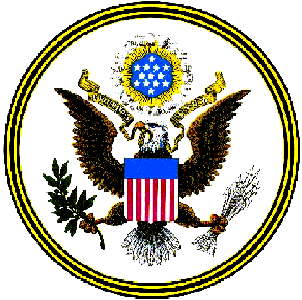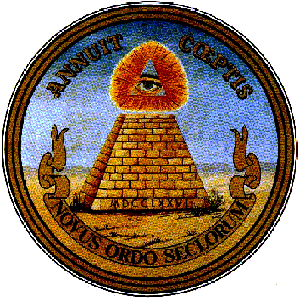Become A Sponsor
|
Why Ads

The
Great Seal and
The National Mottos
of the United States of America
This page concentrates on the history of the
Great Seal of the United States and the National Motto of the United States
(In God We Trust).
The Great Seal of the United States of
America
On July 4, 1776 the Continental Congress set a
committee to work to design a national seal. The task was a monumental one
since the feeling was that it reflected the Founding Fathers' beliefs, values
and sovereignty of the new Nation. Original designs varied widely. Benjamin
Franklin and Thomas Jefferson proposed a design representing Moses crossing
the Red Sea, with Pharaoh in hot pursuit. It included the motto: 'Rebellion
to tyrants is obedience to God'. The task was not complete until the current
design was approved by Congress on June 20, 1782.
The device or design on the obverse (front) of
the Great Seal is the coat of arms (emblem) of the United States. Strictly
speaking without the crest (constellation of stars). Used apart from the seal
for a number of official government purposes. The coat of arms is the symbol
and badge of the United States Government.
The Great Seal of the United States, both
obverse and reverse, is pictured on the back of the $1 bill.
The seal is a heraldic device, and as such,
each element has a specific meaning.

Obverse
(Front)
The American bald eagle is prominently
featured supporting a shield composed of 13 red and white stripes (pales)
representing the Thirteen Original states with a blue bar (chief) uniting the
shield and representing Congress. The shield is born on the breast of the
eagle without any other supporters to denote that the United States ought to
rely on their own virtue. The motto of the United States E Pluribus Unum (out
of many, one) is emblazoned on the scroll held in the eagle's beak and refers
to this union. The olive branch (dexter talon) and
13 arrows (sinister talon) grasped by the eagle allude to peace and war,
powers solely vested in the Congress, and the constellation of stars (crest), breaking through a cloud symbolizes the new Nation
taking its place among the sovereign powers. The eagle faces right, which is
proper in heraldry.
The colors have specific meanings. The colors
red, white and blue did not have a meaning for the flag when adopted in 1777,
but do have meaning in the seal.
- white -- purity and
innocence
- red -- hardiness and
valor
- blue - color of the
Chief represents vigilance, perseverance and justice

Reverse
(Back)
The unfinished pyramid signifies strength and
duration: The eye over it and the motto, Annuit
Coeptis (He, [God,] has favored our
undertakings), allude to the many interventions of Providence in favor of the
American cause. The Roman numerals below are the date of the Declaration of
Independence. The words under it, novus Ordo Seclorum (a new order
of the ages), signify the beginning of the new American era beginning in
1776.
Frequently Asked Questions about the Great
Seal
Where is the Great Seal stored?
The Great Seal (obverse only) is used to
emboss the design upon international Treaties and other official U.S.
Government documents. Used 2-3,000 times a year, the die, counter die, press
and cabinet in which they are housed are located in the Exhibit Hall of the
Department of State inside a locked glass enclosure. An officer from the
Department's Presidential Appointments Staff does the actual sealing of
documents after the Secretary of State has countersigned the President's signature.
Why is the seal
called 'great'?
The seal is called 'great' by tradition. A
'great' seal is used to represent the government of a country. In the case of
the United States, it is used to authenticate the President's signature on
certain state documents. Some countries, such as in the case of the British
privy seal, have 'lesser' seals that are used to signify the royal family.
The United States does not use the concept of a 'lesser' seal, however it
still uses the word 'great' in the title of the Great Seal.
Has the Eagle always faced the olive
branch?
Yes, since the first die was cast, the eagle
has always faced right and has held the olive branch in its right talon.
Presidential
flags, seals (and coats of arms) showed the eagle facing left, towards
the arrows, until 1945 when President Truman changed a number of items in the
presidential flag and seal [Executive Order 9646].One of the changes was to have the eagle
face right, towards the olive branch "This new flag faces the eagle
toward the staff," Truman explained, "which is looking to the front
all the time when you are on the march, and also has him looking at the olive
branch for peace, instead of the arrows for war ...” President Truman meant
the shift in the eagle's gaze to be seen as symbolic of a nation both on the
march and dedicated to peace. It has remained that way ever since.
Contrary to a popular myth, the eagle in the Presidential
seal does not flip his gaze during times of war. Although when Truman and
Churchill were looking at the new symbol on a train car, Churchill remarked
that he thought the eagle's head should be on a swivel. That may be the origin of the myth. In any case, it is incorrect. The arrows and olive branches are always
held in the same claws.
Is it true that Benjamin Franklin really
wanted the turkey as the national symbol?
Benjamin Franklin's idea for a coat of arms
was of Moses crossing the Red Sea (see above), however almost eight years
after his service on the seal committee, and after a design for the seal had
been adopted and put into use, Franklin expressed his distaste for the bald
eagle as the symbol of the country to a letter to his daughter in 1784.
Franklin was probably not writing seriously, as he had promptly used the
Great Seal device, with the eagle, in two publications printed on his press
at Passy in 1783. But the story has been widely
disseminated.
Did freemasonry influence the Great Seal
designs?
Because membership records for the
Revolutionary period are scattered and imperfect, it is not possible to
answer this with complete certainty. There is no evidence that the final
designers of the Great Seal, Charles Thomson or Philadelphia William Barton,
were Masons. It is more likely that the seal designers of the Great Seal and
the Masons took their symbols from parallel sources.
The National Mottos
In God We Trust
The national motto originated with Secretary
of the Treasury Salmon P. Chase during the Civil War. Prompted by a letter
from Rev. M. R. Watkinson, of Ridleyville,
Pennsylvania asking for a recognition of "the Almighty God in some form
in our coins.", Chase requested Congress to
pass a law changing the composition of the 2-cent piece to include the motto
"In God we trust". The law as passed on April 22, 1864. Eventually
the motto appeared on many U.S. coins and currencies.
When the double eagle and eagle of new design
appeared in 1907, it was soon discovered that the motto had been omitted. In
response to a general demand, Congress ordered it restored, and the act of
May 18, 1908, made mandatory its appearance upon all coins which it had
heretofore appeared. The act approved July 11, 1955, makes appearance of the
motto "In God we trust" mandatory upon all coins of the United
States. (69 Stat. 290. 31 U.S. Code 324a)
On July 30, 1956 a law was passed stating that
"the national motto of the United States is hereby declared to be 'In
God we trust'." (70 Stat. 732. 36 U.S. Code 186). The House Judiciary
Committee recognized that the phrase E Pluribus Unum had also received wide
usage in the United States, and the joint resolution did not repeal or
prohibit its use as a national motto. In 1963 the Department of State took
the following position: "'In God we trust'" is the motto of
the United States. It seems to the Department, nevertheless, that there is
ample basis both in history and in law for calling 'E Pluribus Unum' a
motto of the United States." The Congress has used both.
E Pluribus Unum
E Pluribus Unum means "out of many,
one". It comes from a popular publication during revolutionary times
entitled Gentleman's Magazine which carried that legend upon the title
page. The magazine was well known to literate Americans of the time. The Gentleman's
Magazine obtained the legend from an earlier and long out of print
publication called the Gentleman's Journal which used the motto in
1692. And perhaps ultimately to Virgil, St. Augustine or Horace. It was first
used extensively in the United States only after it was introduced on the
Great Seal.
Frequently Asked Questions about the National
Mottos
Have federal court cases cast doubt on
the constitutionality of the motto "In God we trust"?
The federal courts have held that the motto
symbolizes the historical role of religion in our society, Lynch, 465 U.S. at
676, formalizes our medium of exchange, see O'Hair v. Blumenthal, 462 F. Supp. 19, 20 (W.D. Tex.), aff'd sub nom. O'Hair v. Murray, 588 F.2d 1144 (5th Cir.
1978) (per curiam), and cert. denied, 442 U.S.930
(1979), fosters patriotism, see Aronow v. United
States, 432 F.2d 242, 243 (9th Cir. 1970), and expresses confidence in the
future, Lynch, 465 U.S. at 692-93 (O'Connor, J., concurring). The motto's
primary effect is not to advance religion; instead, it is a form of
"ceremonial deism" which through historical usage and ubiquity
cannot be reasonably understood to convey government approval of religious
belief. Allegheny, 492 U.S. at 625 (O'Connor, J., concurring); Lynch, 465
U.S. at 693 (O'Connor, J., concurring); id. at 716
(Brennan, J., dissenting). Finally, the motto does not create an intimate
relationship of the type that suggests unconstitutional entanglement of
church and state. O'Hair, 462 F. Supp. at 20.
"After making [inquiries], we find that a reasonable observer, aware of
the purpose, context, and history of the phrase "In God we trust,"
would not consider its use or its reproduction on U.S. currency to be an
endorsement of religion. (Gaylor vs USA, 10th Cir. 1996)
References
- Our Flag, Joint
Committee on Printing, United States
Congress, 1989
- The Eagle and the
Shield, Department of State, 1976
- The Great Seal of
the United States, Dept.
of State publication, 1980.
- Presidential Seal Speaks of Peace, Newsday. 6 January 1995.
- Truman, David McCullough, New York: Touchstone Books, 1993.
Created by: Bill
Nelson, Venturing Committee Chairman, Grand Canyon Council, Boy Scouts of America. Please let me know of any additions
or corrections.
|





